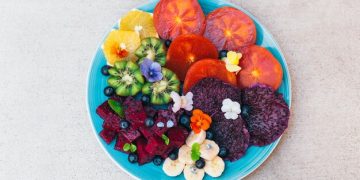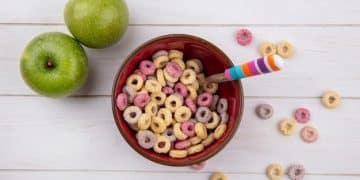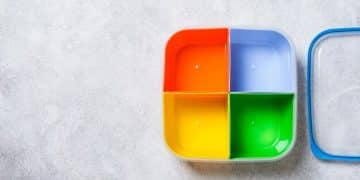Hidden Sugars in Kids’ Snacks: Your 2025 Nutrition Label Guide

Hidden sugars in kids’ snacks pose a significant concern for parents. This 2025 guide provides essential knowledge to decode nutrition labels effectively, helping you make informed and healthier choices for your children, ensuring a balanced diet and a brighter future.
Navigating the world of kids’ snacks can feel like a minefield, especially when it comes to hidden sugars in kids’ snacks. As we head into 2025, understanding how to read nutrition labels effectively has never been more crucial. This guide will equip you with the knowledge to make healthier choices for your children.
Understanding the Sweet Threat: Why Hidden Sugars Matter
It’s easy to assume that a snack marketed towards children is automatically a healthy choice. However, many popular kids’ snacks are loaded with hidden sugars, contributing to various health issues. Understanding why these sugars matter is the first step in making informed decisions.
The Health Implications of Excessive Sugar
Excessive sugar intake has serious consequences for children’s health. From weight gain and dental problems to hyperactivity and an increased risk of chronic diseases later in life, the dangers are far-reaching.
- Weight Gain and Obesity: Sugary snacks contribute significantly to calorie intake without providing essential nutrients, leading to weight gain and obesity.
- Dental Health: Sugar feeds bacteria in the mouth, leading to tooth decay and cavities, which can impact a child’s overall health.
- Hyperactivity and Mood Swings: Rapid spikes and drops in blood sugar levels can cause hyperactivity, irritability, and difficulty concentrating.
- Increased Risk of Chronic Diseases: A high-sugar diet early in life can increase the risk of developing type 2 diabetes, heart disease, and other chronic conditions.
The Psychological Impact of Sugary Snacks
Beyond the physical health implications, sugary snacks can also affect a child’s behavior and emotional well-being. Sugar can be addictive, leading to cravings and dependence. Creating healthy eating habits early on is crucial for long-term well-being.
By recognizing the potential harm caused by hidden sugars, parents can take proactive steps to protect their children’s health. Educating yourself and your children about healthy choices is essential for promoting a healthier lifestyle.
Decoding Nutrition Labels: A Step-by-Step Guide for 2025
Nutrition labels can be confusing, but they are your most valuable tool in identifying hidden sugars in kids’ snacks. This step-by-step guide will walk you through the key sections of a nutrition label, helping you decipher what you’re really feeding your children.
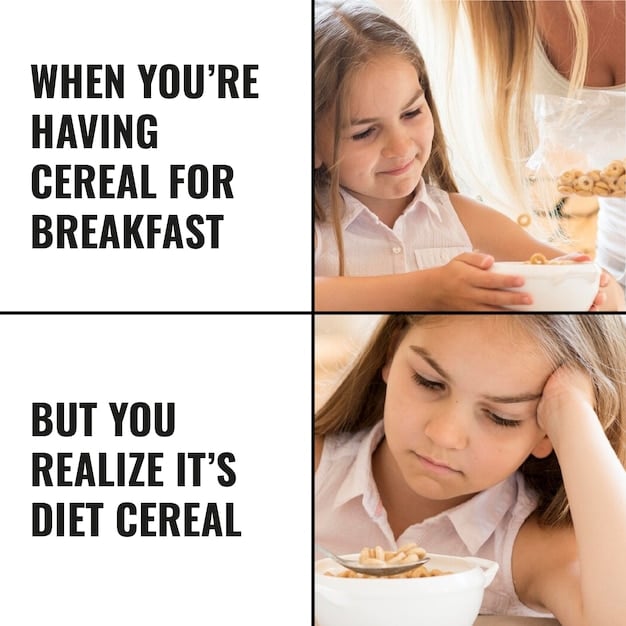
Understanding Serving Size
The information on a nutrition label is based on a specific serving size. Pay close attention to the serving size and adjust the values accordingly if your child consumes more or less than the listed amount.
Locating Total Sugars and Added Sugars
The “Total Sugars” section includes both naturally occurring sugars (like those found in fruits) and added sugars. “Added Sugars” are the sugars that have been added during processing, and these are the ones you should be most concerned about.
- Total Sugars: This includes all sugars present in the product, both naturally occurring and added.
- Added Sugars: This refers to sugars added during the manufacturing process.
- Daily Value: The % Daily Value (%DV) indicates how much of a nutrient a serving of food contributes to a total daily diet.
Reading the Ingredient List
The ingredient list can reveal hidden sugars that aren’t always obvious in the nutrition facts panel. Sugars can come in many forms, and manufacturers often use different names to disguise them. Learning to recognize these alternative names is crucial for informed decision-making.
By mastering these key skills, you’ll be well-equipped to navigate nutrition labels and make healthier choices for your kids. Remember, knowledge is power when it comes to protecting your family’s health.
The Many Faces of Sugar: Recognizing Hidden Sources
Sugar isn’t always listed as “sugar” on ingredient lists. Food manufacturers use a variety of names to mask the presence of added sugars. Learning to identify these aliases is crucial for detecting hidden sugars in kids’ snacks.
Common Sugar Aliases
Here are some of the most common names for added sugars found in snack foods:
- High-Fructose Corn Syrup: A widely used sweetener derived from cornstarch.
- Sucrose: Table sugar, a combination of glucose and fructose.
- Glucose: A simple sugar that is a primary source of energy for the body.
- Fructose: A simple sugar found in fruits and honey.
- Dextrose: Another form of glucose, often used as a sweetener.
Less Obvious Sugar Sources
Some sugar aliases are less obvious and can easily be overlooked. These include:
Honey and Nectars
Though often perceived as healthier alternatives, honey and nectars are still forms of added sugar and should be consumed in moderation. They provide minimal nutritional value and can contribute to excess sugar intake.
- Agave Nectar: A sweetener derived from the agave plant.
- Maple Syrup: A natural sweetener made from maple tree sap.
- Molasses: A byproduct of sugar refining, containing concentrated sugars.
Syrups and Concentrates
Syrups and fruit juice concentrates are often used to add sweetness and flavor, but they are essentially concentrated forms of sugar. Be wary of these ingredients, especially in snacks marketed towards children.
By familiarizing yourself with these various sugar aliases, you can become a more vigilant label reader and protect your children from consuming excessive amounts of added sugars. Knowledge is key to making healthier choices.
Snack Swaps: Healthier Alternatives for Kids
Finding healthier snack alternatives for your kids doesn’t have to be difficult. There are plenty of delicious and nutritious options that will satisfy their cravings without loading them up on hidden sugars in kids’ snacks. Here are some simple snack swaps you can make.
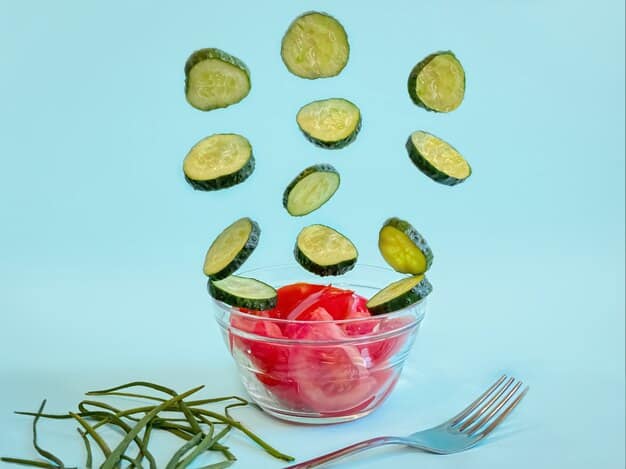
Fresh Fruits and Vegetables
These are naturally sweet and packed with vitamins, minerals, and fiber. Offer a variety of colorful fruits and veggies to make snack time more appealing.
- Berries: Strawberries, blueberries, raspberries, and blackberries are low in sugar and high in antioxidants.
- Apples: A good source of fiber and naturally sweet.
- Carrots and Celery: Crunchy and satisfying when paired with a healthy dip like hummus.
Homemade Snacks
Making your own snacks allows you to control the ingredients and avoid added sugars. Here are a few ideas:
Energy Bites
Combine oats, nut butter, seeds, and a touch of honey or maple syrup for a quick and nutritious snack. These can be customized to suit your child’s preferences.
Popcorn
Air-popped popcorn is a whole-grain snack that is low in calories and high in fiber. Avoid store-bought versions loaded with butter and salt; instead, add your own seasonings like nutritional yeast or herbs.
Making simple snack swaps can dramatically reduce your children’s sugar intake and promote healthier eating habits. It’s about making informed choices and finding options that are both nutritious and appealing.
Empowering Kids: Teaching Children About Healthy Choices
It’s never too early to start teaching children about the importance of healthy eating. By involving them in the process and empowering them to make informed choices, you can instill lifelong healthy habits and reduce their reliance on hidden sugars in kids’ snacks.
Involving Kids in Grocery Shopping
Bring your children along when you go grocery shopping and involve them in the selection of healthy snacks. Teach them how to read nutrition labels and compare different products.
Making Healthy Eating Fun
Present healthy snacks in an appealing way. Use colorful containers, create fun shapes with fruits and vegetables, and let them participate in preparing their own snacks.
- Create a Snack Station: Designate a specific area in the refrigerator or pantry for healthy snacks that are easily accessible to your children.
- Use Fun Presentations: Cut fruits and vegetables into fun shapes using cookie cutters or arrange them in colorful patterns on a plate.
- Involve Kids in Cooking: Let children help with simple tasks like washing fruits and vegetables or measuring ingredients for homemade snacks.
Leading by Example
Children learn by observing the adults around them. Make sure you are also making healthy choices and modeling positive eating habits. Your actions will speak louder than words.
By empowering your children with knowledge and involving them in the process of making healthy choices, you can help them develop a positive relationship with food and reduce their consumption of hidden sugars. It’s a long-term investment in their health and well-being.
Looking Ahead: The Future of Nutrition Labeling in 2025
As we move closer to 2025, there is growing awareness of the impact of hidden sugars in kids’ snacks, and nutrition labeling is evolving to provide consumers with more transparent and useful information. Staying informed about these changes can help you make even better food choices for your family.
Potential Changes in Nutrition Labeling
There is ongoing discussion and advocacy for more comprehensive and user-friendly nutrition labels. These changes may include:
- More Prominent Added Sugar Information: Making the “Added Sugars” line more prominent and easier to locate on nutrition labels.
- Clearer Serving Size Guidelines: Standardizing serving sizes to reflect realistic consumption amounts.
- Front-of-Package Labeling: Introducing simplified labels on the front of packages that highlight key nutritional information, such as sugar content.
The Role of Technology
Technology is playing an increasingly important role in helping consumers make informed food choices. Smartphone apps and online resources can provide real-time nutritional information and suggest healthier alternatives.
By staying informed about potential changes in nutrition labeling and leveraging technology, you can be even more proactive in protecting your children from hidden sugars and promoting a healthier lifestyle. The future of nutrition labeling is focused on providing consumers with the tools they need to make informed decisions.
| Key Point | Brief Description |
|---|---|
| 🍬 Identifying Hidden Sugars | Learn to spot sugar aliases in ingredient lists. |
| 🍎 Snack Swaps | Opt for fresh fruits, vegetables, and homemade snacks. |
| 👨👩👧👦 Involving Children | Educate kids about making healthier choices. |
| 🏷️ Reading Labels | Check total and added sugars on nutrition labels. |
[Frequently Asked Questions]
▼
Hidden sugars are added sugars in foods under various names, like corn syrup or dextrose. They can lead to weight gain, dental issues, and increase the risk of chronic diseases in children.
▼
Look for the “Added Sugars” line on the nutrition facts panel. Also, check the ingredient list for common sugar aliases like high-fructose corn syrup, sucrose, or dextrose.
▼
Opt for fresh fruits and vegetables, homemade snacks like energy bites, and air-popped popcorn. These options provide nutrients without the added sugars of processed snacks.
▼
Bring them grocery shopping, teach them to read labels, and make healthy eating fun by presenting snacks attractively. Involve them in preparing homemade snacks too!
▼
Read nutrition labels carefully, choose whole, unprocessed foods, control portion sizes, and limit sugary drinks. By making smart choices, you can significantly reduce sugar intake.
Conclusion
By becoming informed about hidden sugars in kids’ snacks and implementing practical strategies like decoding nutrition labels, choosing healthier alternatives, and empowering your children to make smart choices, you can significantly improve your family’s health and well-being. Take the first step today towards a sugar-conscious lifestyle!


